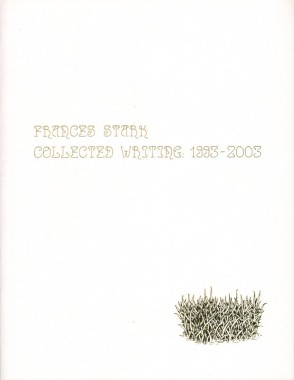
Frances Stark, Collected Writing: 1993–2003
Softcover, 160 pp., offset 4/1, 215 x 280 mm
Edition of 2000
ISBN: 978-1-870699-63-1
Published by Book Works
$49.00 · out of stock
This book brings together many of Stark’s texts for the first time, including essays on artists and text pieces. Stark’s writing is not specifically sited in visual art, but is rooted in the condition of contemporary life, encountering along the way literary tradition, music and philosophy. These provide the backbone to much of her thinking, as do the problems faced by being both an artist and writer today. These themes are presented through a pseudo-autobiographical style that frequently presents itself as poetic musings, creating meandering, off-centred texts that are often humorous and at the same time highly readable.
This book also includes facsimiles of “The Unspeakable Compromise of the Portable Work of Art” as well as specially designed pages by Stark, making this anthology a fascinating insight into the artist’s practice. Includes a forward by Matthew Higgs.
Art, Book Works, Frances Stark, Galerie Daniel Buchholz, Marc Foxx, Matthew Higgs
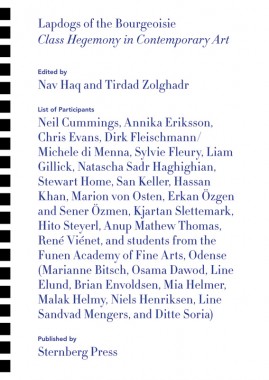
Nav Haq and Tirdad Zolghadr, Lapdogs of the Bourgeoisie
Softcover, 180 pp., offset 4/1, 170 x 240 mm
Edition of 2000
ISBN 978-1-933128-88-7
Published by Sternberg Press
$25.00 ·
Class inevitably raises awkward questions for the protagonists of contemporary art — about their backgrounds, patrons and ideological proclivities. Lapdogs of the Bourgeoisie investigates this latent yet easily overlooked issue, which has been historically eclipsed by gender, sexuality, ethnicity and nationality. This book creates a conversation on a sensitive subject, bringing together essays by art-world types including artists, curators and critics. On one hand, the ideas here raise the question of whether a given socio-economic background still helps define an artistic career — and to which point this career might reflect or consolidate the hierarchies in question. On the other hand, the project asks whether the traditional ways of analyzing class structure are actually helpful in an examination of who makes art today.
Amanda Beech, Annika Eriksson, Anup Mathew Thomas, Arnolfini, Art, Charlotte Bydler, Chris Evans, Criticism, Dirk Fleischmann, Fatham Adel, Gasworks, Hassan Khan, Karim Abo El Fath, Liam Gillick, Malcolm Quinn, Marion von Osten, Michele di Menna, Natascha Sadr Haghighian, Neil Cummings, Platform Garanti, RAM, San Keller, Sternberg Press, Suhail Malik, Tensta Konsthall, Townhouse Gallery, Wessal Abd El Aziz, Zak Kyes
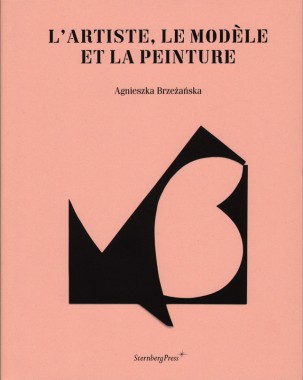
Agnieszka Brzezanska, L’artiste, Le Modèle et La Peinture
Softcover, 120 pp., offset 4/1, 185 x 235 mm
Edition of 2000
ISBN 978-1-933128-98-6
Published by Sternberg Press
$25.00 ·
The first monograph for Polish-born Agnieszka Brzezanska, this artist book offers a compelling compilation of her mysterious, subtle and deeply felt photographs, paintings and videos. The book’s title was taken from a poster for a Picasso exhibition that the artist photographed and used as the poster for her own show — creating a ready-made accentuating the rain-smudged lettering of the original poster. The peach-colored cover of this soft-cover book — with its image of a kinked heart referring to her heart paintings and her musical video, Heart Play — makes the book seem like something discovered at a kiosk on the banks of the Seine. The monograph was developed while Brzezanska was a guest of the Berlin DAAD artist-in-residence program. With a compelling essay by Andrew Renton.
Agnieszka Brzezanska, Andrew Renton, April Lamm, Ariane Beyn, Art, Franz Stauffenberg, Janek Bersz, Kasha Bittner, Katrin Sauerlander, Melinda Braathen, Photography, RAM, Sternberg Press, Tadeusz Mirosz, Tatjana Gunthner
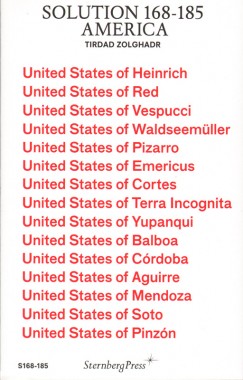
Tirdad Zolghadr, Solution 168-185: America
Softcover, 112 pp., offset 2/1, 110 x 180 mm
Edition of 2000
ISBN 978-1-933128-90-0
Published by Sternberg Press
$19.00 ·
Solution 168–185: America is the fourth book in the Solution series. Opting for the United States of America, “still the most proficiently colonial place I know,” Zolghadr provides a compilation of highly entertaining “solutions,” where the objective is not the education of America so much as the pleasure of a text that purports to be just that. Tirdad Zolghadr is a writer/curator based in Berlin. He is editor-at-large for Cabinet magazine. He organized the United Arab Emirates pavilion, Venice Biennale 2009, and the long-term project Lapdogs of the Bourgeoisie (with Nav Haq). Zolghadr teaches at the Center for Curatorial Studies, Bard College.
Art, Criticism, Ingo Niermann, Kari Rittenbach, Matthew Evans, RAM, Solution, Sternberg Press, Theory, Tirdad Zolghadr, Zak Kyes
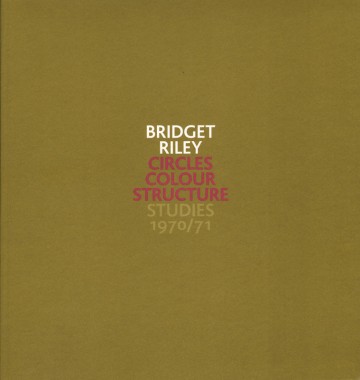
Bridget Riley, Circles, Colour Structure Studies 1970/71
Softcover, 48 pp., offset 4/4, 245 x 260 mm
Edition of 1000
ISBN 978-1-905464-19-7
Published by Ridinghouse
$35.00 ·
This elegant, slim catalog accompanies Bridget Riley’s exhibition Circles Colour Structure: Studies 1970/71, shown at Karsten Schubert in London. This series of 22 gouaches was shown and published here for the first time, accompanied by an interview between the artist and her close friend Robert Kudielka, done in 1972, just following the creation of the works. “The studies I make have different purposes,” Riley said. “Obviously, many studies will be discarded en route to a painting, though they may still be interesting as visual statements.” A fascinating look at the process of this important artist.
Art, Bridget Riley, Karsten Schubert, RAM, Robert Kudielka, Rosalind Home, Tim Harvey
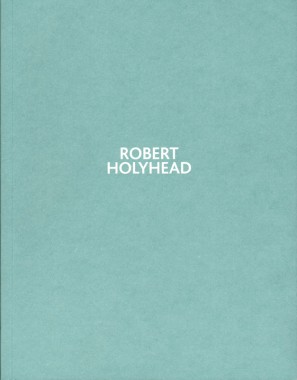
Robert Holyhead, New Paintings
Softcover, 24 pp., offset 4/4, 205 x 275 mm
Edition of 1000
ISBN 978-1-905464-24-1
Published by Ridinghouse
$22.00 ·
This small but beautifuly produced exhibition catalog presents ten new paintings by the British artist Robert Holyhead. His work is marked by expanses of white ground left uncovered and traces of color at the canvas-edge where paint has been carefully removed from the surface. In dialog with Holyhead’s paintings is an in-depth essay by art historian Anna Lovatt. She discusses how the work is temporally bounded by the moment of the paint’s application and the point at which it begins to dry. Together, this group of paintings demonstrates the surprisingly diverse outcomes of this restricted situation.
Anna Lovatt, Art, Ben Parsons, Doro Globus, Francis Atterbury, Gemma Lloyd, Karsten Schubert, Matthew Hollow, Maureen Holyhead, RAM, Robert Holyhead, Tim Harvey
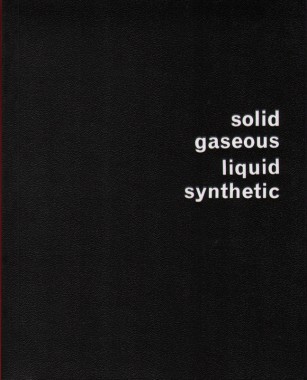
Simon Patterson, Rex Reason (solid gaseous liquid synthetic)
Softcover, 116 pp., offset 5/1, 105 x 130 mm
Edition of 2000
ISBN 978-1-870699-13-6
Published by Book Works
$16.00 ·
Rex Reason presents the Periodic Table of the Elements in book form. A colour-coding system is set up (black for solids, blue for liquids and yellow synthetics) but where we might expect to find hydrogen, helium or lithium we find Yul Brynner, William Hogarth and Maria Callas. The selected names relate to the chemical symbol for each element: both letters must appear in the chosen name for example, Bertolt Brecht (Br, Bromine).
A loose logic prevails in the choice of names, for example names in red, gases, are from Greek myth or history and the yellow synthetic elements are given their proper names. However, Patterson disrupts this system with red herrings, mysteries and riddles that test the reader’s knowledge and that expose the inherent human desire to establish order and meaning.
Art, Bertolt Brecht, Book Works, Design, Maria Callas, RAM, Rex Reason, Simon Patterson, Typography, William Hogarth, Yul Brynner
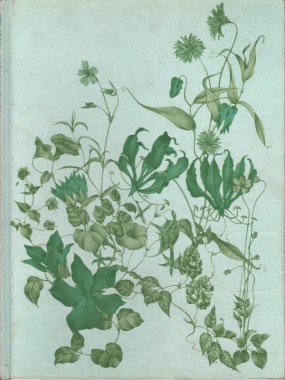
Moira Savonius, all color book of Flowers
Softcover, 72 pp., offset 4/4, 220 x 290 mm
Edition of 5000
ISBN 0-7064-0324-X
Published by Octopus Books
sold
condition:
fair, worn cover, interior in good condition, first edition, excellent reference copy.
all color book of Flowers, published in 1974 by Octopus Books, London. A collection of 100 photographs of flowers from around the world. Color illustration on front and back cover, all color photographs inside. Contents: Flowers that change the landscape; Europe; North America; South America; Australia; Africa; Asia; The development of garden flowers; Acknowledgments.
Culture, Flowers, Horticulture, Moira Savonius, Octopus Books, Photography, Used
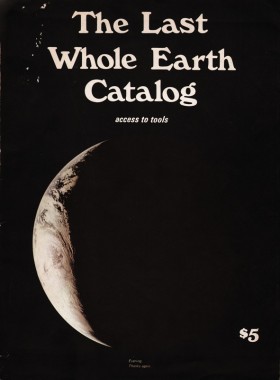
Stewart Brand, The Last Whole Earth Catalog
Softcover, 452 pp., web offset 1/1, 10.75 x 14.25 inches
First edition (1971)
ISBN 0-394-70459-20
Published by Portola Institute
$55.00 · out of stock
condition:
good, edge wear, worn cover/spine, interior discolored, very good reference copy.
We can’t put it together. It is together.
The Whole Earth Catalog is an American counterculture catalog published by Stewart Brand between 1968 and 1972, and occasionally thereafter, until 1998. Although the WECs listed all sorts of products for sale (clothing, books, tools, machines, seeds — things useful for a creative or self-sustainable lifestyle), the Whole Earth Catalogs themselves did not sell any of the products. Instead the vendors and their prices were listed right alongside with the items.
The title Whole Earth Catalog came from a previous project of Stewart Brand. In 1966, he initiated a public campaign to have NASA release the then-rumored satellite photo of the sphere of Earth as seen from space, the first image of the “Whole Earth.” He thought the image might be a powerful symbol, evoking a sense of shared destiny and adaptive strategies from people. The Stanford-educated Brand, a biologist with strong artistic and social interests, believed that there was a groundswell of commitment to thoroughly renovating American industrial society along ecologically and socially just lines, whatever they might prove to be.
Function
The Whole Earth Catalog functions as an evaluation and access device. With it, the user should know better what is worth getting and where and how to do the getting. An item is listed in the Catalog if it is deemed:
1. Useful as a tool
2. Relevant to independent education
3. High quality or low cost
4. Not already common knowledge
5. Easily available by mail
Catalog listings are continually revised according to the experience and suggestions of Catalog users and staff.
Purpose
We are as gods and might as well get good at it. So far, remotely done power and glory — as via government, big business, formal education, church — has succeeded to the point where gross defects obscure actual gains. In response to this dilemma and to these gains a realm of intimate, personal power is developing — power of the individual to conduct his own education, find his own inspiration, shape his own environment, and share his adventure with whoever is interested. Tools that aid this process are sought and promoted by The Whole Earth Catalog.
Agriculture, Architecture, Art, California, Criticism, Culture, Don Gerrard, Earth, Education, Eleanor Watkins, Larry Kline, Les Rosen, Mitzi O'Dell, Nancy Wirth, NASA, Portola Institute, Richard Raymond, Stewart Brand, Survival, Used, Vern John, Whole Earth Catalogue
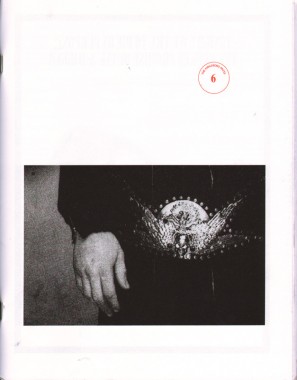
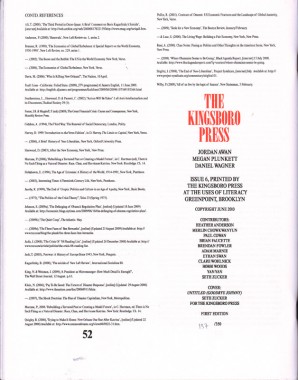
The Kingsboro Press 6
Softcover, 52 pp., mimeograph 3/1, 8.5 x 11 inches
Edition of 350
Published by The Kingsboro Press
$20.00 ·
Issue 6 of The Kingsboro Press, mimeograph printed by The Kingsboro Press at The Uses of Literacy in Greenpoint, Brooklyn. Contributors: Heather Anderson, Merlin Chowanyun, Paul Cowan, Brian Faucette, Brendan Fowler, Adam Marnie, Ethan Swan, Clare Wohlnick, Bobbi Woods, Yan Yan, Seth Zucker.
Adam Marnie, Art, Bobbi Woods, Brendan Fowler, Brian Faucette, Clare Wohlnick, Daniel Wagner, Distribution, Ethan Swan, Heather Anderson, Jordan Awan, Megan Plunkett, Paul Cowan, Seth Zucker, The Kingsboro Press, The Uses of Literacy, Yan Yan
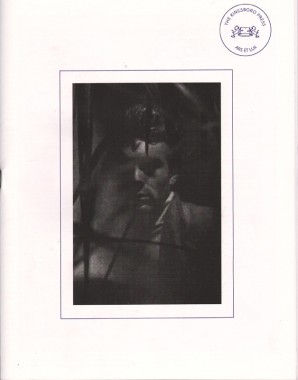
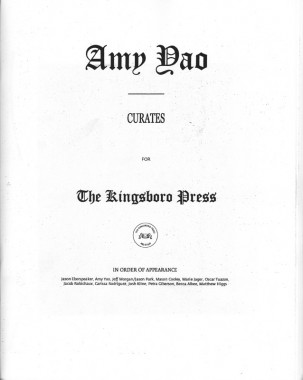
The Kingsboro Press 5
Softcover, 52 pp., mimeograph 3/1, 8.5 x 11 inches
supplement: Amy Yao Curates for The Kingsboro Press
Softcover, 44 pp., mimeograph 1/1, 8.5 x 11 inches
Edition of 350
Published by The Kingsboro Press
$20.00 ·
Issue 5 of The Kingsboro Press, mimeograph printed by The Kingsboro Press at The Uses of Literacy in Greenpoint, Brooklyn. Contributors: Becca Albee, Jordan Awan, Dan Arps, The Changes, Mason Cooley, Chris Barton, Milano Chow, Dru Donovan, Jason Eberspeaker, Richard Elliot, Ryan Foerster, Alex Gartenfeld, Zoe Ghertner, Petrova Giberson, Bieanca Hester, Matthew Higgs, David Horovitz, Marie Jager, Thomas Jeppe, Josh Kline, Maxwell Krivitsky, Aude Levere, Mondo Mondo, Jeff Morgan, Dan Moynihan, Jason Park, Asher Penn, Megan Plunkett, Jacob Robichaux, Carissa Rodriguez, Joshua Ray Stephens, Ethan Swan, Oscar Tuazon, Alex Vivian, Daniel Wagner, Jessica WIlliams, Amy Yao, Doniella Davy.
Alex Gartenfeld, Alex Vivian, Amy Yao, Art, Asher Penn, Aude Levere, Becca Albee, Bieanca Hester, Carissa Rodriguez, Chris Barton, Dan Arps, Dan Moynihan, Daniel Wagner, David Horovitz, Distribution, Doniella Davy, Dru Donovan, Ethan Swan, Jacob Robichaux, Jason Eberspeaker, Jason Park, Jeff Morgan, Jessica WIlliams, Jordan Awan, Josh Kline, Joshua Ray Stephens, Marie Jager, Mason Cooley, Matthew Higgs, Maxwell Krivitsky, Megan Plunkett, Milano Chow, Mondo Mondo, Oscar Tuazon, Petrova Giberson, Richard Elliot, Ryan Foerster, The Changes, The Kingsboro Press, The Uses of Literacy, Thomas Jeppe, Zoe Ghertner

Erhard Wagner and Christoph Schubert-Weller, Earth and Cave Architecture of Peter Vetsch
Hardcover, 136 pp., offset 4/4, 305 x 225 mm
English and German
ISBN 3-7212-0282-1
Published by Verlag Niggli
$49.00 · out of stock
The architect Peter Vetsch of Dietikon, Switzerland is a controversial figure. No one is indifferent to him. His earth-covered-dwellings — often called “cave houses” — belong to the most highly individual, yet simplest and clearest design forms in modern architecture.
Foreword by Max Bill.
Anthroposophy, Architecture, Caves, Christoph Schubert-Weller, Erhard Wagner, Max Bill, Peter Vetsch, RAM, Rudolf Steiner, Verlag Niggli
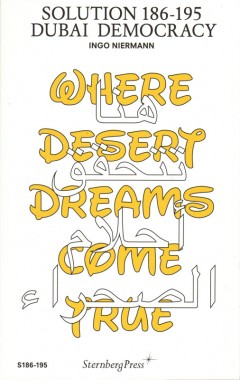
Ingo Niermann, Solution 186-195: Dubai Democracy
Softcover, 128 pp., offset 3/1, 110 x 180 mm
Edition of 2000
ISBN 978-1-934105-17-7
Published by Sternberg Press
$19.00 · out of stock
Using Dubai as a sort of modernist blank slate for urban and social renewal, author Ingo Niermann — a relentlessly creative artist whose tongue is firmly jammed into his cheek — confronts today’s most relevant cultural and technological developments with elixirs that are as pertinent as they are unbelievable. In the fifth book in the Solution series, Niermann sees Dubai, a sparsely populated piece of desert, become specialized as housing the global center for treating diabetes, called
Sugar World. And the Gulf state will be Kumbaya-style universal, too, offering non-confrontational public spaces where both a state of total advertising and compulsive kindness, or what he calls a “personal humaneness account,” co-exist.
“Ingo Niermann is the author and brain behind some of the most intriguing and bizarre intellectual speculations of the last years.”
—Fabrizio Gallanti, Abitare
Architecture, Art, Criticism, Culture, Fabrizio Gallanti, Ingo Niermann, RAM, Solution, Sternberg Press, Theory, Zak Keyes














